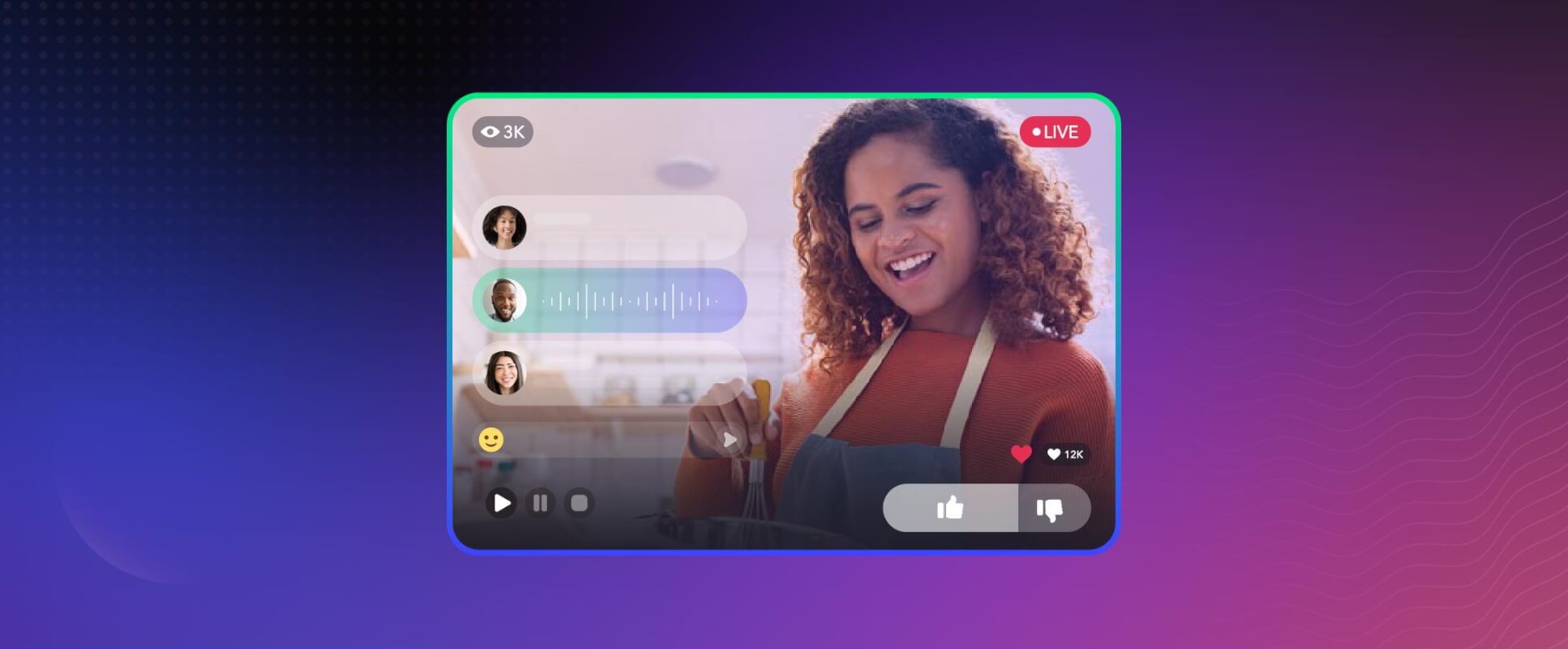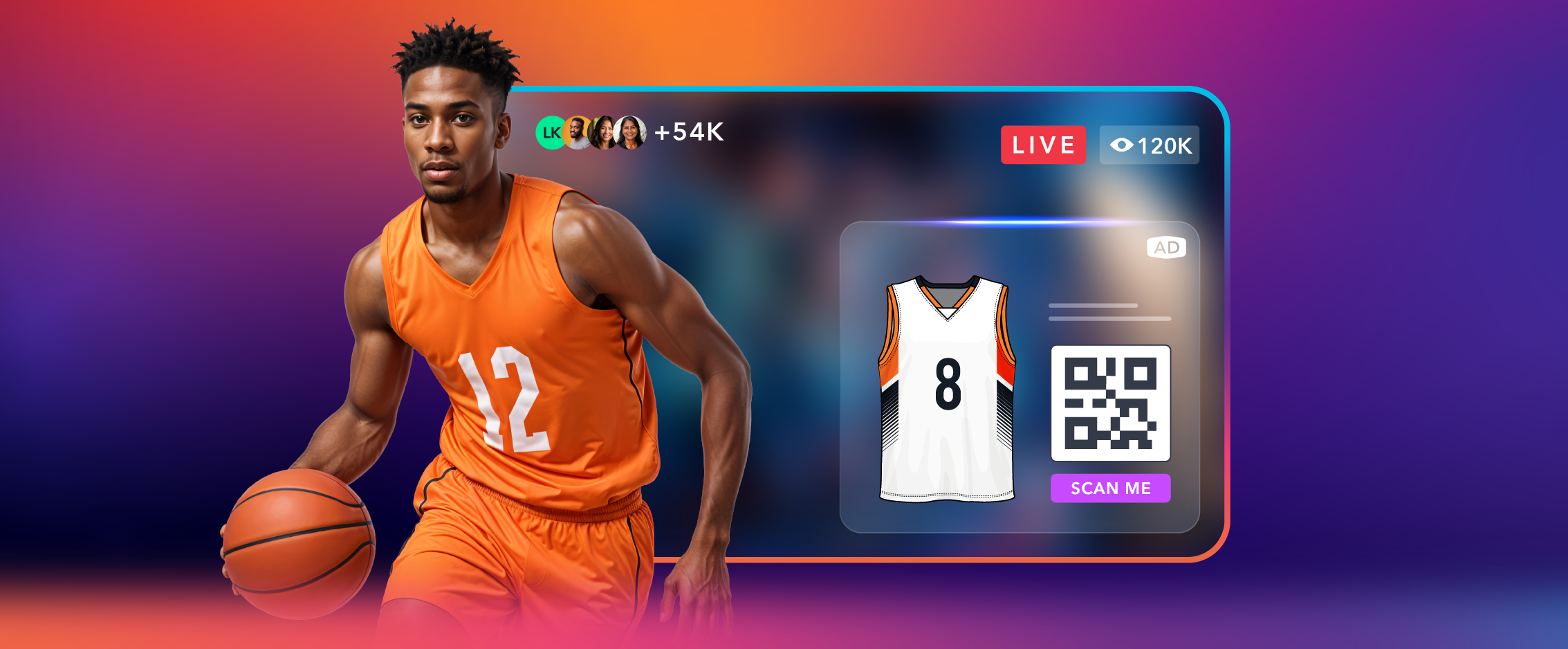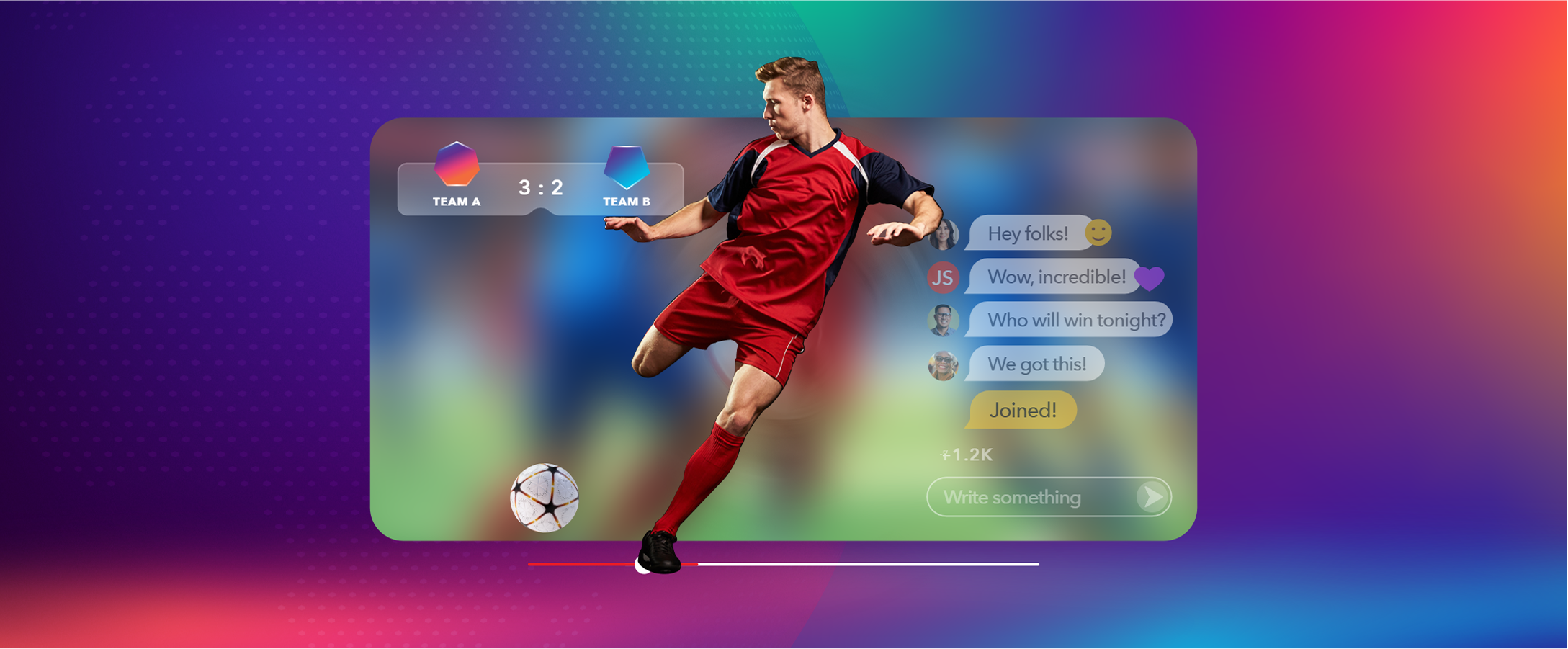Interactive live streaming is a rapidly growing trend in the live streaming industry. It has exploded in the past few years, but it is on track to expand even further as related technology develops rapidly.
These tools allow broadcasters and media publishers to establish direct connections and interactions with their viewers, enhancing viewer satisfaction. For businesses, the ability to attract and retain viewer interest translates into increased revenue and growth potential.
These strategies lead to a significant increase in overall engagement, a surge in repeat viewership, and ultimately, an amplified revenue stream for investors.
This guide covers everything you need to know about interactive live streaming, including how it works, its benefits, examples, and tips for success.
What is interactive live streaming?
Interactive live streaming, as the name suggests, is a type of live streaming that allows viewers to interact directly with the content creators and other viewers in real-time.
Unlike traditional live streaming, where interaction is limited to comments and likes only, interactive live streaming offers an immersive, real-time engagement experience. It enables viewers to converse with each other, pose questions to the broadcaster, place live bets, and even participate in bidding for items being auctioned.
Benefits of interactive live streaming
One of the main benefits of interactive live streaming from a content creator’s perspective is the ability to build a loyal fan base. When viewers are empowered to interact with broadcasters in real time, they are more likely to perceive them as approachable and relatable, making viewers feel like they are an integral part of the content being created.
Live streaming is a great way to expand your reach and cultivate relationships with viewers who share similar interests. However, there are many other valuable benefits to interactive real-time video streaming.
Let’s review a few of the most significant advantages of interactive live streaming.
Connect with the audience
Live streaming makes it easier to get to know your audience and connect with like-minded individuals worldwide. Since all interactions are live, you can communicate directly with viewers and provide immediate responses. This can help build your brand’s reputation and trust.
Plus, some interactive streaming tools have built-in analytics tools that help you collect even more data. Combining this insight with the observations from your real-time interactions enables you to shape the user experience by curating a more relevant and interesting stream for your viewers.
Build a community
Interactive streaming is a powerful tool for building a community. Over time, regular viewers may hop into your stream, which serves as the foundation of a loyal fanbase.
Viewer interaction features, like live chats, are very valuable because regulars can connect with you about your stream, your brand’s mission, and more. This encourages more engagement and prolonged viewership.
You can use interactive tools to create a community beyond the stream. For example, you could integrate clickable CTAs to follow, subscribe to, or join your community on your various social media platforms. You could also use an email gate with your interactive content to collect contact information and stay connected with your community.
Plus, fostering a sense of community can boost brand awareness, promote loyalty, and increase your following.
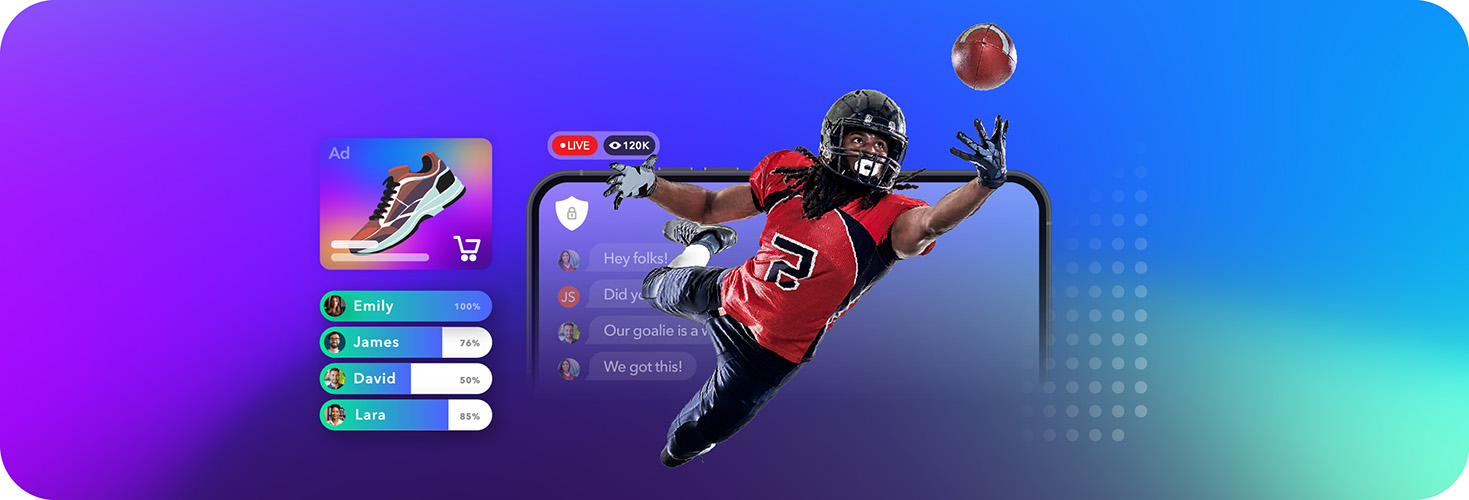
Increased accessibility
Interactive live stream video content gives people remote access to live events like conferences, concerts, and lectures, regardless of location. While some people may not be able to attend in-person events, online streaming allows anyone to participate in virtual events.
Additionally, users can watch the stream at any time and on any device if the recording is available. Adding closed captioning to your live streams can further boost their accessibility.
Creates more personal experiences
Live streaming makes it easy to show off your genuine personality. Providing authentic, personal interactions with your audience can help improve engagement and viewership with later streams.
Since interactivity fosters two-way communication, individual viewers can be addressed during the stream. This makes viewers feel seen and enriches the experience. Viewers may tune in more often as you provide more value and create more personalized experiences.
Cost-effective after initial setup
Obtaining the right equipment and software for streaming requires an initial investment. However, once you begin streaming, you can generate additional revenue and offset the cost of those expenses.
Many live streaming platforms enable you to earn a commission by running ads, while others allow you to create recurring revenue by requiring viewers to subscribe to your channel for a set price.
Boost conversions
Using live streaming to your advantage, you can advertise your brand and online store. Doing so can help drive traffic to your business and boost conversions. Calls to action are also more effective during a live stream than in pre-recorded or static content.
8 Interactive live streaming examples
Interactive live streaming is very valuable across many industries. Let’s examine some of the top use cases for this style of broadcast.
1. Concerts and live performances
Streaming concerts and live performances enable you to connect with those who cannot attend these events in person. This can also be great for new artists who don’t have the resources to tour or perform at local venues.
2. iGaming and casino streaming
Live dealer casinos offer a unique online gambling experience that replicates the thrill of being at a real casino. Players can see, interact, and place real-time bets with real dealers through live streaming technology. The dealers respond to players’ actions just like in a physical casino, dealing cards or spinning the roulette wheel accordingly. This creates an interactive environment where viewers can make bets based on live gameplay, offering a more immersive and authentic casino experience from the comfort of their own homes.
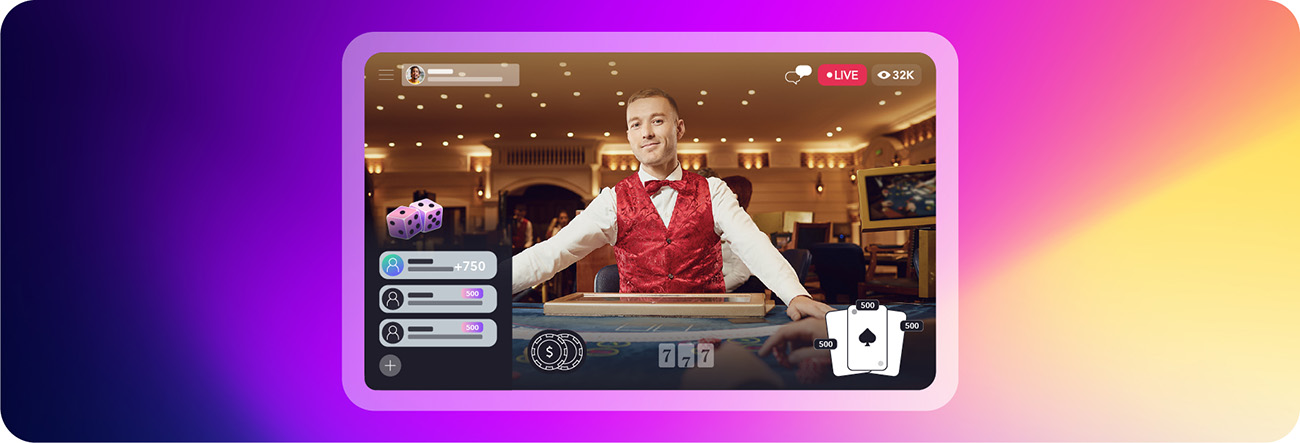
3. Live sports betting
Live sports betting, also known as in-play wagering, offers a dynamic and interactive way for viewers to engage with sports events. As the action unfolds in real-time, bettors can place wagers on various aspects of the game, such as the outcome of a play, the next team to score, or the final result.
These bets can be made anytime during the event, adding excitement and unpredictability. Live sports betting brings an immersive, real-time dimension to traditional sports wagering, heightening viewer engagement and participation.
4. Webinars
A webinar is a live event stream that serves as an online alternative to a seminar. This sort of event is typically used to present products or services, educate people about a specific subject, and present your brand as an industry expert.
Webinars often last 30 minutes to an hour to make the content easy to digest. However, with interactivity, you can extend the event to include breakout sessions, Q&As, and other segments that facilitate dialogue with and among the viewers.
5. Tutorials
Some interactive live streams allow viewers to tune in to learn how to accomplish a specific project or task.
For instance, viewers may take a virtual cooking class to learn how to make a delicious vegan dish for their next potluck. Alternatively, they may watch a live tutorial to learn how to answer interview questions.
Since tutorials are a versatile streaming format, they can be used in many industries.
6. Live shopping
Live shopping streams allow you to showcase your products to a virtual audience who may be viewing your stream from around the world. For example, clothing brands may conduct live shopping streams to highlight the details of their products, show viewers how to wear the garment, and accept orders on the spot.
7. Gaming
Video game streaming is an $8.4 billion industry that is on track to hit a market value of nearly $14 billion by 2030. As this industry grows, gaming content creators can leverage interactivity to get their piece of the pie.
With interactive gaming streaming, viewers can feel like they are in a Discord server or other chat room, gaming alongside creators and fellow fans.
8. Auctions
A live auction is an interactive stream where bidding occurs in real time. It is often used to purchase items that may be harder to find or of higher value than typical retail products. During a live auction, bidders compete for the item sold by raising their bids incrementally until one bidder remains the winner.
How does interactive live streaming work?
Interactive live streaming works by capturing and broadcasting video and audio in real time over the Internet. The process of turning live footage into streamable content is somewhat complicated on a technical level.
Here’s what’s going on behind the scenes:
- Your computer will process the raw video captured by your webcam and turn it into digital data via segmentation.
- The data will be compressed to create a smaller file size and encoded into a more acceptable format, like H.264 or AV1.
- The compressed and encoded file will be sent to the CDN (content delivery network) so viewers can tune in.
- Devices that receive the stream will decode and decompress the video, while the media player allows the stream to play.
Throughout this process, live streaming platforms often use buffering and adaptive bitrate streaming to ensure smooth playback regardless of network conditions. The result is a seamless viewing experience that feels immediate and interactive.
Understanding this technical process in its basic form is useful because it will help you make decisions about your streaming setup.
What you need for interactive live streaming
For real-time streaming, you’ll need the following:
- Internet-enabled device: Smartphones and tablets can be used for streaming, but a PC or laptop is better suited.
- Broadcasting software: Streamlabs, OBS Studio, Restream, and XSplit Broadcaster are examples of broadcasting software. These applications will process your content to make it viewable on streaming platforms.
- Streaming equipment: If you want to live stream, it’s a great idea to obtain a webcam, microphone, headset, good lighting, and a streaming desktop computer or laptop.
- CDN: Interactive streaming requires the support of a real-time streaming media server using WebRTC with global distribution.
Once you’ve gathered everything necessary for your live stream, decided what you want to talk about, and tested your broadcasting equipment, it’s time to hit the “go live” button.

How to make live streams more interactive
Ready to make your live streams more interactive? Here are a few things you can do to make your content more engaging with interactivity.
1. Understand your audience
Understanding your audience lets you tailor your content to their interests and needs. It also allows you to identify the best platform to stream and share your content.
A great way to understand your audience is to use social listening. You can do this by going through your brand’s social media posts, threads, and relevant groups. You can also have a team member engage in chats during the stream.
If your brand is relatively new, you can always check out similar media publishers’ streams or social media profiles to see how viewers interact with their content.
2. Make it a two-way conversation
Enhancing the interactivity of your streams can significantly boost viewer engagement. Start by integrating real-time chats to allow viewers to share their thoughts and opinions.
Polls and quizzes are also practical tools for fostering interaction, inviting the audience to participate directly in the stream. Additionally, consider hosting Q&A sessions or taking viewer requests to make your audience feel more involved.
3. Plan your talking points
Even if you aren’t using the interactivity elements we discussed above, you can create a more engaging, interactive stream by keeping the conversation going even if you aren’t getting a response.
You can make this happen by planning a few reference points to spark a conversation. You don’t have to script every moment of your stream, but having talking points will help you remember everything you want to say and avoid any lulls.
4. Get strategic with production
Interactivity can be incorporated at the production level. For example, interactive graphics or overlays can add a dynamic element to your streams. You could also consider a multiview approach for different camera angles.
At the very least, you should ensure your stream looks good. While aesthetics isn’t everything, a high-quality, 4K stream with appealing graphics can attract viewers. Check for any audio issues and test your microphone volume before going live.
Final thoughts
An interactive live stream makes it easy to connect with any audience in real time, regardless of their location.
Whether you’re using this form of streaming for iGaming, marketing, or to build a community with like-minded individuals, making your content as professional as possible is vital. Doing so can boost the quality of your stream and keep viewers engaged.
Dolby OptiView lets you broadcast real-time streams to create interactive streaming experiences for a global audience. We deliver broadcast-quality live streaming at sub-second latency. Contact us to learn how you can incorporate our solution into your interactive live streaming tech stack.



